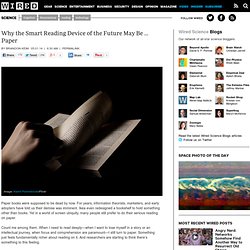

Richardson-student editors. Richardson-collaborative filters. Albersvasquezharste_tp_classroomwview.
Reading 2.0. Many educators are worried about how technology is affecting the amount of reading that students are doing.
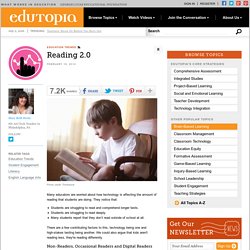
They notice that: Students are struggling to read and comprehend longer texts.Students are struggling to read deeply.Many students report that they don’t read outside of school at all. There are a few contributing factors to this, technology being one and high-stakes testing being another. We could also argue that kids aren't reading less, they're reading differently. Non-Readers, Occasional Readers and Digital Readers. Creating a Custom Reading Experience with Mobile Devices. I'll admit it.
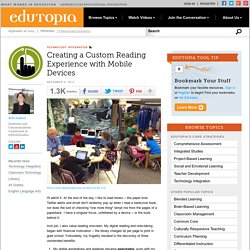
At the end of the day, I like to read books -- the paper kind. Do Your Students Read Critically? How do you tell if someone has been reading a book critically?
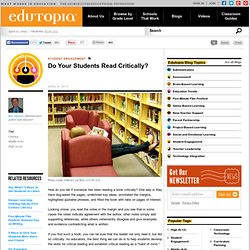
One way is they have dog-eared the pages, underlined key ideas, annotated the margins, highlighted quotable phrases, and filled the book with tabs on pages of interest. Looking closer, you read the notes in the margin and you see that in some cases the notes indicate agreement with the author, other notes simply add supporting references, while others vehemently disagree and give examples and evidence contradicting what is written. If you find such a book, you can be sure that the reader not only read it, but did so critically.
As educators, the best thing we can do is to help students develop the skills for critical reading and establish critical reading as a "habit of mind. " Questioning Text In these margin conversations with the author, the student asks questions that seek more evidence, understanding or examples. Digital Annotation. Position Statement on Multimodal Literacies. Critical Search Skills Students Should Know. There is a new digital divide on the horizon.

It is not based around who has devices and who does not, but instead the new digital divide will be based around students who know how to effectively find and curate information and those who do not. Helene Blowers has come up with seven ideas about the new digital divide – four of them, the ones I felt related to searching, are listed below. USE...filters. Digital & Media Literacy Fundamentals. Teaching Adolescents How to Evaluate the Quality of Online Information. An essential part of online research is the ability to critically evaluate information. This includes the ability to assess its level of accuracy, reliability, and bias. In 2012, my colleagues and I assessed 770 seventh graders in two states to study these areas, and the results definitely got our attention.
Unfortunately, over 70 percent of the students’ responses suggested that: Deconstructing Web Pages - Teaching Backgrounder. Imagine that you're a secondary student using the Internet to research a science project on the artificial sweetener, Aspartame.
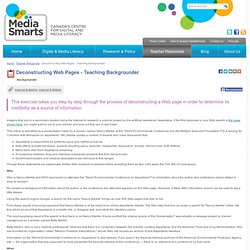
If the first response to your Web search is the page shown here, you might want to run to your kitchen and toss out that can of diet Coke. This article is identified as a presentation made by a woman named Nancy Markle at the "World Environmental Conference and the Multiple Sclerosis Foundation F.D.A Issuing for Collusion with Monsanto on Aspartame. " Ms. Lesson Template - TIP Online Think-Aloud Lessons. Instructional Strategies for Critically Evaluating Online Information.
Question: How do I know if the information is useful for my research?

Learning Objective: Integrating strategies for verifying the accuracy of information and author's level of expertise Activity 1. Work with your group to brainstorm strategies for critically evaluating the information at a website. ThinkAloud Japanese Internment During World War 2. What A 21st Century Book Looks Like. Technology touches almost everything in 2013.
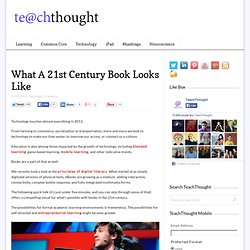
From farming to commerce, socialization to transportation, more and more we look to technology to make our lives easier, to improve our access, or connect us a culture. Education is also among those impacted by the growth of technology, including blended learning, game-based learning, mobile learning, and other indicative trends. Prensky - Digital Natives, Digital Immigrants - Part1. 5 Dimensions Of Critical Digital Literacy: A Framework. 5 Dimensions Of Critical Digital Literacy: A Framework Digital Literacy is increasingly important in an age where many students read as much on screens as they do from books.
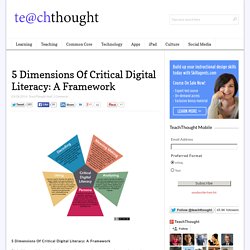
In fact, the very definition of many of these terms is changing as the overlap across media forms increases. Interactive eBooks can function like both long-form blogs and traditional books. Threaded email can look and function like social media. Email and texting and social media messaging are increasingly similar. This is the modern digital era. The above framework was developed by Juliet Hinrichsen and Antony Coombs at the University of Greenwich. 4 Principals Of Digital Literacy. Literacy Literacy is the ability to make sense of something, often generalized as the ability to read and write.
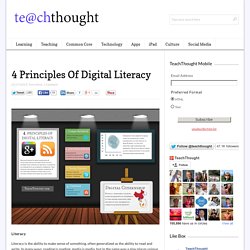
In many ways, reading is reading, media is media, but in the same way a play places unique comprehension demands on a reader compared to a poem or a letter, so do digital media compared to classic media forms. In the 21st century, new literacies are emerging and digital media forms allow communication to be more nuanced than ever before. Digital Literacy Digital Literacy is about being able to make sense of digital media.
Critical Digital Literacy. Multimodal Literacy. How Does Electronic Reading Affect Comprehension? Why the Smart Reading Device of the Future May Be … Paper. Paper books were supposed to be dead by now.
